The Impact of 3D Prism Cavity for Enhanced Oil Recovery Using Different Nanomaterials
Abstract
1. Introduction
2. Mathematical Model
2.1. Assumptions
- i.
- There is only one-dimensional flow as it moves through the cavity.
- ii.
- The rock in the reservoir is thought to be sandstone and tidy.
- iii.
- The fluid that exits the cavity is incompressible.
- iv.
- The Darcy Law is in effect during the flooding process.
- v.
- The effect of chemical reactions is ignored.
- vi.
- The flow inside the cavity is isothermal.
- vii.
- The nanofluid flow is Newtonian, and the effect of gravity is ignored.
2.2. Geometry Creation
2.3. Mathematical Equations
2.4. Initial and Boundary Conditions
2.5. Mesh Test
2.6. Experimental Validation
3. Results
4. Discussion
5. Conclusions
- The nanoparticles introduced the relative permeability of the oil and water phases into the cavity change, reducing friction between the two. This reduces the capillary forces that keep oil in reservoirs and makes recovery easier.
- The oil recovery rate increases as the flow rate decreases, and the maximum amount of oil recovered at Q = 0.05 mL/min is 99.1% in the case of Si, which shows that the effect of flow is very important in reservoir geometry to obtain maximum oil recovery.
- It is also observed that with an increase in the nanoparticle concentration at each pore volume injection, the oil recovery rate also increases.
- It was also discovered that the reservoir’s shape has a substantial impact on oil recovery enhancement, since it directly influences flow behavior, which can increase oil recovery.
- The findings also indicate that Si provides a 6.3% higher recovery than Al2O3.
Author Contributions
Funding
Institutional Review Board Statement
Informed Consent Statement
Data Availability Statement
Conflicts of Interest
References
- El-Masry, J.F.; Bou-Hamdan, K.F.; Abbas, A.H.; Martyushev, D.A. A Comprehensive Review on Utilizing Nanomaterials in Enhanced Oil Recovery Applications. Energies 2023, 16, 691. [Google Scholar] [CrossRef]
- Afolabi, R.O. Enhanced oil recovery for emergent energy demand: Challenges and prospects for a nanotechnology paradigm shift. Int. Nano Lett. 2019, 9, 1–15. [Google Scholar] [CrossRef]
- Zafar, M.; Sakidin, H.; Sheremet, M.; Dzulkarnain, I.; Nazar, R.M.; Hussain, A.; Said, Z.; Afzal, F.; Al-Yaari, A.; Khan, M.S.; et al. The Impact of Cavities in Different Thermal Applications of Nanofluids: A Review. Nanomaterials 2023, 13, 1131. [Google Scholar] [CrossRef]
- Zafar, M.; Sakidin, H.; Sheremet, M.; Dzulkarnain, I.B.; Hussain, A.; Nazar, R.; Khan, J.A.; Irfan, M.; Said, Z.; Afzal, F.; et al. Recent Development and Future Prospective of Tiwari and Das Mathematical Model in Nanofluid Flow for Different Geometries: A Review. Processes 2023, 11, 834. [Google Scholar] [CrossRef]
- Rezk, M.Y.; Allam, N.K. Impact of nanotechnology on enhanced oil recovery: A mini-review. Ind. Eng. Chem. Res. 2019, 58, 16287–16295. [Google Scholar] [CrossRef]
- Zafar, M.; Sakidin, H.; Dzulkarnain, I.; Afzal, F. Numerical Investigations of Nano-fluid Flow in Square Porous Cavity: Buongiorno’s Mathematical Model. In Proceedings of the 6th International Conference on Fundamental and Applied Sciences; Springer: Singapore, 2021; pp. 739–748. [Google Scholar]
- Davoodi, S.; Al-Shargabi, M.; Wood, D.A.; Rukavishnikov, V.S.; Minaev, K.M. Experimental and field applications of nanotechnology for enhanced oil recovery purposes: A review. Fuel 2022, 324, 124669. [Google Scholar] [CrossRef]
- Shi, F.; Wu, J.; Zhao, B. Preparation and investigation of intelligent polymeric nanocapsule for enhanced oil recovery. Materials 2019, 12, 1093. [Google Scholar] [CrossRef]
- Zhao, W.; Tang, H.; Lu, F.; Hu, S.; Liu, T.; Li, N.; Song, R. Mathematical model for oil recovery prediction of polymer microsphere conformance control based on the stream tube method. Materials 2023, 16, 1476. [Google Scholar] [CrossRef]
- Kaood, A.; Abubakr, M.; Al-Oran, O.; Hassan, M.A. Performance analysis and particle swarm optimization of molten salt-based nanofluids in parabolic trough concentrators. Renew. Energy 2021, 177, 1045–1062. [Google Scholar] [CrossRef]
- Fadodun, O.G.; Kaood, A.; Hassan, M.A. Investigation of the entropy production rate of ferrosoferric oxide/water nanofluid in outward corrugated pipes using a two-phase mixture model. Int. J. Therm. Sci. 2022, 178, 107598. [Google Scholar] [CrossRef]
- Hussain, A.; Muthuvalu, M.S.; Faye, I.; Zafar, M.; Inc, M.; Afzal, F.; Iqbal, M.S. Numerical investigation of treated brain glioma model using a two-stage successive over-relaxation method. Comput. Biol. Med. 2022, 153, 106429. [Google Scholar] [CrossRef] [PubMed]
- Lashari, N.; Ganat, T. Emerging applications of nanomaterials in chemical enhanced oil recovery: Progress and perspective. Chin. J. Chem. Eng. 2020, 28, 1995–2009. [Google Scholar] [CrossRef]
- Lashari, N.; Ganat, T.; Elraies, K.A.; Ayoub, M.A.; Kalam, S.; Chandio, T.A.; Qureshi, S.; Sharma, T. Impact of nanoparticles stability on rheology, interfacial tension, and wettability in chemical enhanced oil recovery: A critical parametric review. J. Pet. Sci. Eng. 2022, 212, 110199. [Google Scholar] [CrossRef]
- Corredor, L.M.; Husein, M.M.; Maini, B.B. Effect of hydrophobic and hydrophilic metal oxide nanoparticles on the performance of xanthan gum solutions for heavy oil recovery. Nanomaterials 2019, 9, 94. [Google Scholar] [CrossRef] [PubMed]
- Hussain, A.; Faye, I.; Muthuvalu, M.S.; Tang, T.B.; Zafar, M. Advancements in Numerical Methods for Forward and Inverse Problems in Functional near Infra-Red Spectroscopy: A Review. Axioms 2023, 12, 326. [Google Scholar] [CrossRef]
- Kumar, M.D.; Raju, C.S.K.; Sajjan, K.; El-Zahar, E.R.; Shah, N.A. Linear and quadratic convection on 3D flow with transpiration and hybrid nanoparticles. Int. Commun. Heat Mass Transf. 2022, 134, 105995. [Google Scholar] [CrossRef]
- Al-Yaari, A.; Ching, D.L.C.; Sakidin, H.; Muthuvalu, M.S.; Zafar, M.; Alyousifi, Y.; Saeed, A.A.H.; Haruna, A. Optimum Volume Fraction and Inlet Temperature of an Ideal Nanoparticle for Enhanced Oil Recovery by Nanofluid Flooding in a Porous Medium. Processes 2023, 11, 401. [Google Scholar] [CrossRef]
- Al-Yaari, A.; Ching, D.L.C.; Sakidin, H.; Muthuvalu, M.S.; Zafar, M.; Alyousifi, Y.; Saeed, A.A.H.; Bilad, M.R. Thermophysical Properties of Nanofluid in Two-Phase Fluid Flow through a Porous Rectangular Medium for Enhanced Oil Recovery. Nanomaterials 2022, 12, 1011. [Google Scholar] [CrossRef]
- Zhang, Y.; Liu, Q.; Ye, H.; Yang, L.; Luo, D.; Peng, B. Nanoparticles as foam stabilizer: Mechanism, control parameters and application in foam flooding for enhanced oil recovery. J. Pet. Sci. Eng. 2021, 202, 108561. [Google Scholar] [CrossRef]
- Li, X.; Ying, Z.; Jia, Y.; Liu, X.; Yang, T.; Ma, L. Application of nanosphere deep profile control and displacement technology in Chanqing oilfield. Oilfield Chem 2012, 29, 419–422. [Google Scholar]
- Jafarnezhad, M.; Giri, M.S.; Alizadeh, M. Impact of SnO2 nanoparticles on enhanced oil recovery from carbonate media. Energy Sources Part A Recovery Util. Environ. Eff. 2017, 39, 121–128. [Google Scholar] [CrossRef]
- Jafarbeigi, E.; Ahmadi, Y.; Mansouri, M.; Ayatollahi, S. Experimental Core Flooding Investigation of New ZnO− γAl2O3 Nanocomposites for Enhanced Oil Recovery in Carbonate Reservoirs. ACS Omega 2022, 7, 39107–39121. [Google Scholar] [CrossRef]
- Cheraghian, G. Effect of nano titanium dioxide on heavy oil recovery during polymer flooding. Pet. Sci. Technol. 2016, 34, 633–641. [Google Scholar] [CrossRef]
- Cheraghian, G.; Hemmati, M.; Masihi, M.; Bazgir, S. An experimental investigation of the enhanced oil recovery and improved performance of drilling fluids using titanium dioxide and fumed silica nanoparticles. J. Nanostruct. Chem. 2013, 3, 78. [Google Scholar] [CrossRef]
- Almahfood, M.; Bai, B. The synergistic effects of nanoparticle-surfactant nanofluids in EOR applications. J. Pet. Sci. Eng. 2018, 171, 196–210. [Google Scholar] [CrossRef]
- Nowrouzi, I.; Manshad, A.K.; Mohammadi, A.H. Effects of TiO2, MgO, and γ-Al2O3 nano-particles in carbonated water on water-oil interfacial tension (IFT) reduction in chemical enhanced oil recovery (CEOR) process. J. Mol. Liq. 2019, 292, 111348. [Google Scholar] [CrossRef]
- Udoh, T.H. Improved insight on the application of nanoparticles in enhanced oil recovery process. Sci. Afr. 2021, 13, e00873. [Google Scholar] [CrossRef]
- Tajik, S.; Shahrabadi, A.; Rashidi, A.; Jalilian, M.; Yadegari, A. Application of functionalized silica-graphene nanohybrid for the enhanced oil recovery performance. Colloids Surf. A Physicochem. Eng. Asp. 2018, 556, 253–265. [Google Scholar] [CrossRef]
- Aziz, H.; Tunio, S.Q. Enhancing oil recovery using nanoparticles—A review. Adv. Nat. Sci. Nanosci. Nanotechnol. 2019, 10, 033001. [Google Scholar] [CrossRef]
- Ehtesabi, H.; Ahadian, M.M.; Taghikhani, V.; Ghazanfari, M.H. Enhanced heavy oil recovery in sandstone cores using TiO2 nanofluids. Energy Fuels 2014, 28, 423–430. [Google Scholar] [CrossRef]
- Ehtesabi, H.; Ahadian, M.M.; Taghikhani, V. Enhanced heavy oil recovery using TiO2 nanoparticles: Investigation of deposition during transport in core plug. Energy Fuels 2015, 29, 1–8. [Google Scholar] [CrossRef]
- Shah, R.D. Application of nanoparticle saturated injectant gases for EOR of heavy oils. In Proceedings of the SPE Annual Technical Conference and Exhibition, New Orleans, LA, USA, 4–7 October 2009; OnePetro: Richardson, TX, USA, 2009. [Google Scholar]
- Kanj, M.Y.; Rashid, M.; Giannelis, E.P. Industry first field trial of reservoir nanoagents. In Proceedings of the SPE Middle East Oil and Gas Show and Conference, Manama, Bahrain, 20–23 March 2011; OnePetro: Richardson, TX, USA, 2011. [Google Scholar]
- Hendraningrat, L.; Torsæter, O. Metal oxide-based nanoparticles: Revealing their potential to enhance oil recovery in different wettability systems. Appl. Nanosci. 2015, 5, 181–199. [Google Scholar] [CrossRef]
- Hendraningrat, L.; Torsæter, O. Understanding fluid-fluid and fluid-rock interactions in the presence of hydrophilic nanoparticles at various conditions. In Proceedings of the SPE Asia Pacific Oil & Gas Conference and Exhibition, Adelaide, Australia, 14–16 October 2014; OnePetro: Richardson, TX, USA, 2014. [Google Scholar]
- Hendraningrat, L.; Torsæter, O. Effects of the initial rock wettability on silica-based nanofluid-enhanced oil recovery processes at reservoir temperatures. Energy Fuels 2014, 28, 6228–6241. [Google Scholar] [CrossRef]
- Hendraningrat, L.; Li, S.; Torsaeter, O. Enhancing oil recovery of low-permeability Berea sandstone through optimized nanofluids concentration. In Proceedings of the SPE Enhanced Oil Recovery Conference, Kuala Lumpur, Malaysia, 2–4 July 2013; OnePetro: Richardson, TX, USA, 2013. [Google Scholar]
- Rahimi, K.; Adibifard, M. Experimental study of the nanoparticles effect on surfactant absorption and oil recovery in one of the Iranian oil reservoirs. Pet. Sci. Technol. 2015, 33, 79–85. [Google Scholar] [CrossRef]
- Irfan, S.A.; Shafie, A.; Yahya, N.; Zainuddin, N. Mathematical modeling and simulation of nanoparticle-assisted enhanced oil recovery—A review. Energies 2019, 12, 1575. [Google Scholar] [CrossRef]
- Zhang, R.-H.; Zhang, L.-H.; Tang, H.-Y.; Chen, S.-N.; Zhao, Y.-L.; Wu, J.-F.; Wang, K.-R. A simulator for production prediction of multistage fractured horizontal well in shale gas reservoir considering complex fracture geometry. J. Nat. Gas Sci. Eng. 2019, 67, 14–29. [Google Scholar] [CrossRef]
- Wu, Z.; Huiqing, L.; Wang, X.; Zhang, Z. Emulsification and improved oil recovery with viscosity reducer during steam injection process for heavy oil. J. Ind. Eng. Chem. 2018, 61, 348–355. [Google Scholar] [CrossRef]
- Wu, Z.; Liu, H.; Pang, Z.; Wu, C.; Gao, M. Pore-scale experiment on blocking characteristics and EOR mechanisms of nitrogen foam for heavy oil: A 2D visualized study. Energy Fuels 2016, 30, 9106–9113. [Google Scholar] [CrossRef]
- Sepehrnoori, K.; Xu, Y.; Yu, W. Embedded Discrete Fracture Modeling and Application in Reservoir Simulation; Elsevier: Amsterdam, The Netherlands, 2020. [Google Scholar]
- Muther, T.; Nizamani, A.A.; Ismail, A.R. Analysis on the effect of different fracture geometries on the productivity of tight gas reservoirs. Malays. J. Fundam. Appl. Sci. 2020, 16, 201–211. [Google Scholar] [CrossRef]
- Tan, P.; Pang, H.; Zhang, R.; Jin, Y.; Zhou, Y.; Kao, J.; Fan, M. Experimental investigation into hydraulic fracture geometry and proppant migration characteristics for southeastern Sichuan deep shale reservoirs. J. Pet. Sci. Eng. 2020, 184, 106517. [Google Scholar] [CrossRef]
- Jin, F. Principles of enhanced oil recovery. In Physics of Petroleum Reservoirs; Springer: Berlin/Heidelberg, Germany, 2017; pp. 465–506. [Google Scholar]
- Abdelfatah, E.; Soliman, M.; Khattab, H. Improving Heavy Oil Recovery by Nanofluid Injection: The factors Affecting and Mathematical Modelling. J. Pet. Min. Eng. 2014, 17, 88–98. [Google Scholar]
- Ju, B.; Fan, T. Experimental study and mathematical model of nanoparticle transport in porous media. Powder Technol. 2009, 192, 195–202. [Google Scholar] [CrossRef]
- Kjosavik, A.; Ringen, J.; Skjaeveland, S. Relative permeability correlation for mixed-wet reservoirs. SPE J. 2002, 7, 49–58. [Google Scholar] [CrossRef]
- Liu, X.; Civan, F. Characterization and Prediction of Formation Damage in Two-Phase Flow Systems. In Proceedings of the SPE Production Operations Symposium, Oklahoma City, OK, USA, 21–23 March 1993. [Google Scholar] [CrossRef]
- Gruesbeck, C.J.; Collins, R.E. Entrainment and Deposition of Fine Particles in Porous Media. Soc. Pet. Eng. J. 1982, 22, 847–856. [Google Scholar] [CrossRef]
- Ju, B.; Fan, T.; Li, Z. Improving water injectivity and enhancing oil recovery by wettability control using nanopowders. J. Pet. Sci. Eng. 2012, 86, 206–216. [Google Scholar] [CrossRef]
- Joonaki, E.; Ghanaatian, S. The application of nanofluids for enhanced oil recovery: Effects on interfacial tension and coreflooding process. Pet. Sci. Technol. 2014, 32, 2599–2607. [Google Scholar] [CrossRef]
- Feng, Y.; Cao, L.; Shi, E. A numerical investigation of enhanced oil recovery using hydrophilic nanofluids. J. Sustain. Energy Eng. 2017, 5, 67–97. [Google Scholar] [CrossRef]
- Alnarabiji, M.S.; Yahya, N.; Nadeem, S.; Adil, M.; Baig, M.K.; Ghanem, O.B.; Azizi, K.; Ahmed, S.; Maulianda, B.; Klemeš, J.J.; et al. Nanofluid enhanced oil recovery using induced ZnO nanocrystals by electromagnetic energy: Viscosity increment. Fuel 2018, 233, 632–643. [Google Scholar] [CrossRef]
- Parvazdavani, M.; Masihi, M.; Ghazanfari, M.H.; Sherafati, M.; Mashayekhi, L. Investigation of the effect of water based nano-particles addition on hysteresis of oil and-water relative permeability curves. In Proceedings of the SPE International Oilfield Nanotechnology Conference and Exhibition, Noordwijk, The Netherlands, 12–14 June 2012; OnePetro: Richardson, TX, USA, 2012. [Google Scholar]
- Veliyev, E.F.; Aliyev, A.A. Propagation of nano sized CDG deep into porous media. In Proceedings of the SPE Annual Caspian Technical Conference, Baku, Azerbaijan, 5–7 October 2021; OnePetro: Richardson, TX, USA, 2011. [Google Scholar]
- Ahmadi, Y.; Aminshahidy, B. Improving water-oil relative permeability parameters using new synthesized calcium oxide and commercial silica nanofluids. Iran. J. Oil Gas Sci. Technol. 2019, 8, 58–72. [Google Scholar]
- Amedi, H.; Ahmadi, M.-A. Experimental investigation the effect of nanoparticles on the oil-water relative permeability. Eur. Phys. J. Plus 2016, 131, 125. [Google Scholar] [CrossRef]
- Ali, H.; Soleimani, H.; Yahya, N.; Khodapanah, L.; Kozlowski, G.; Sabet, M.; Demiral, B.M.R.; Adebayo, L.L.; Hussain, T. Experimental investigation and two-phase flow simulation of oil and nanofluids on micro CT images of sandstone for wettability alteration of the system. J. Pet. Sci. Eng. 2021, 204, 108665. [Google Scholar] [CrossRef]
- Eltoum, H.; Yang, Y.-L.; Hou, J.-R. The effect of nanoparticles on reservoir wettability alteration: A critical review. Pet. Sci. 2021, 18, 136–153. [Google Scholar] [CrossRef]
- Sircar, A.; Rayavarapu, K.; Bist, N.; Yadav, K.; Singh, S. Applications of nanoparticles in enhanced oil recovery. Pet. Res. 2022, 7, 77–90. [Google Scholar] [CrossRef]
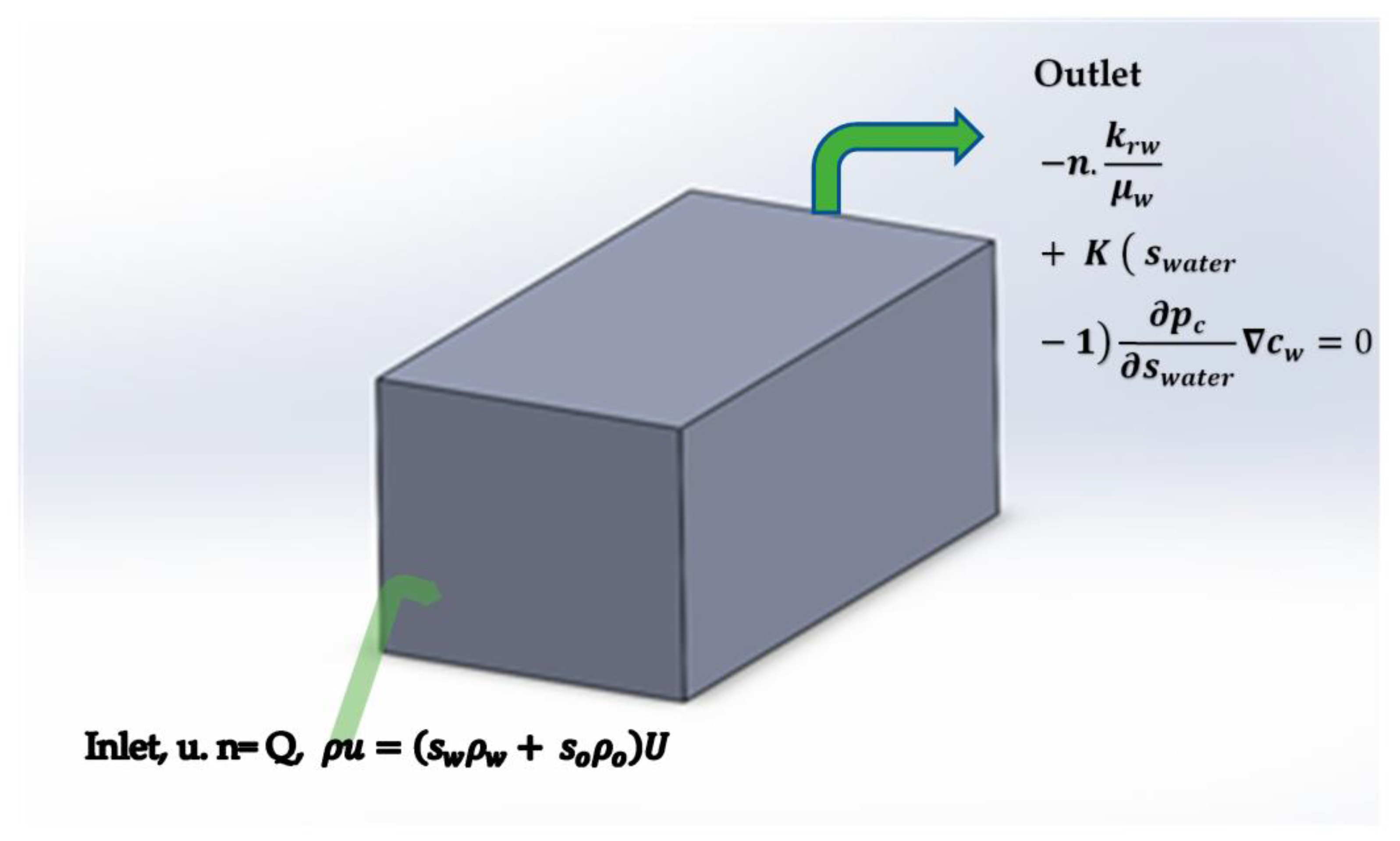
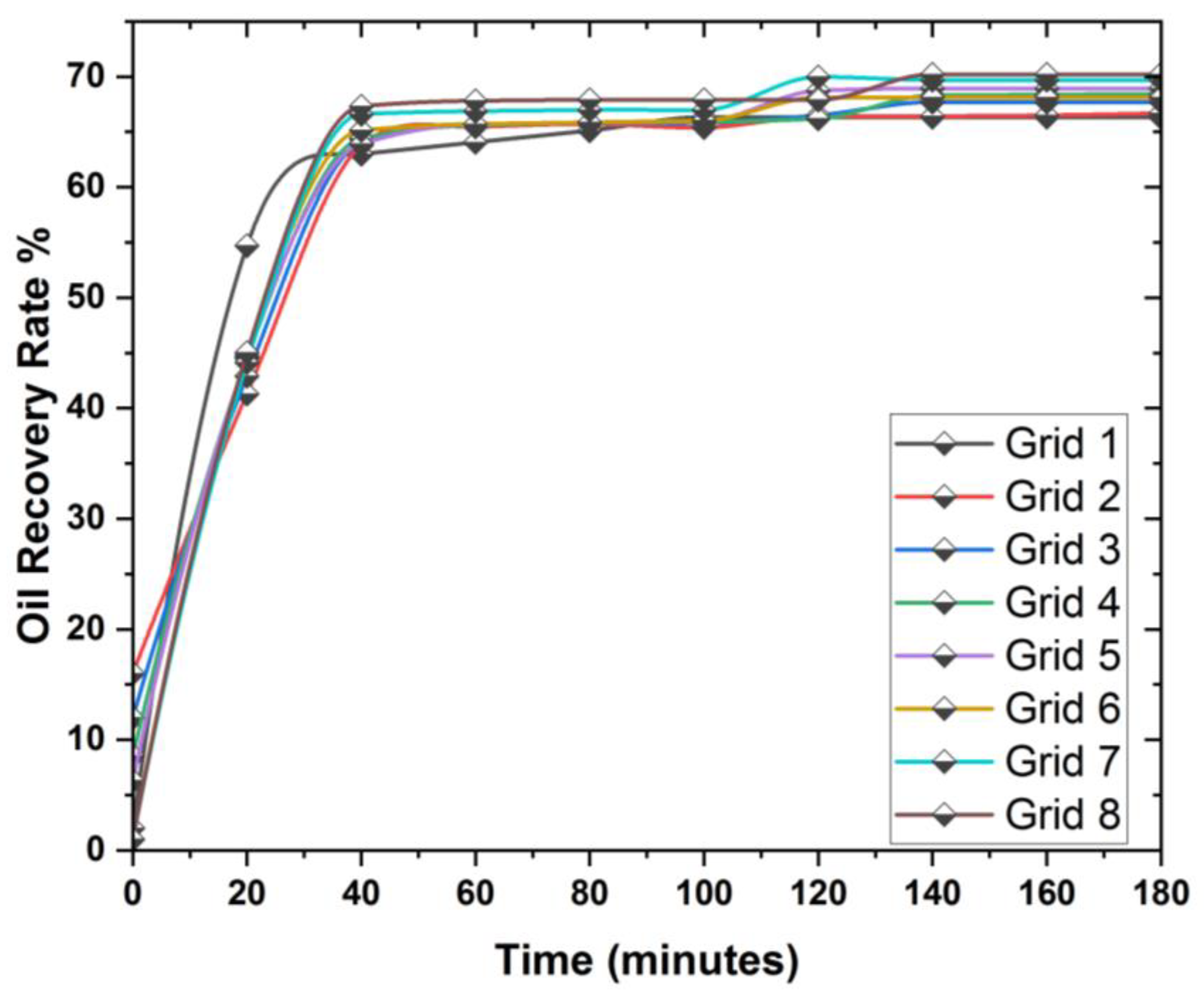
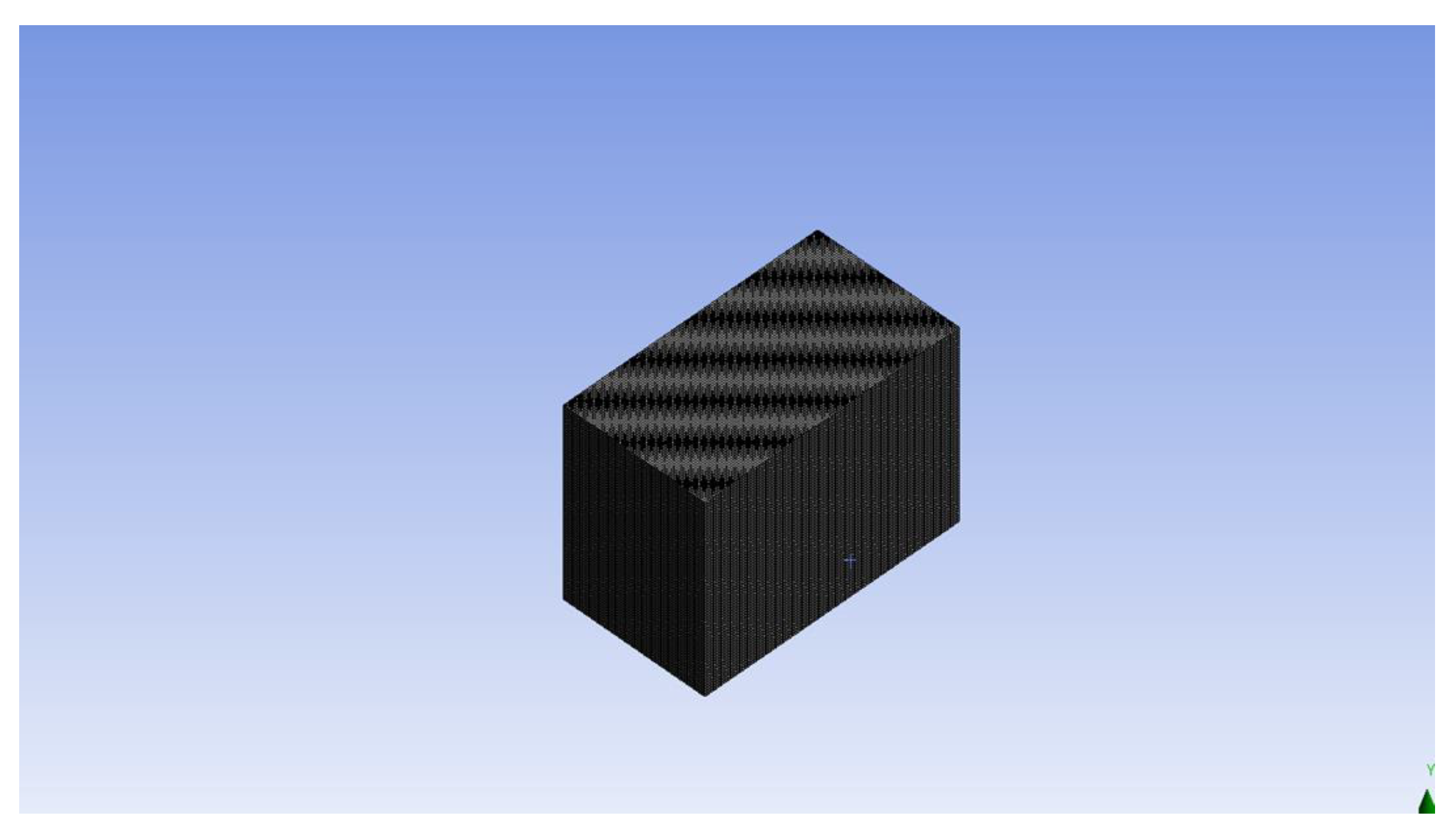
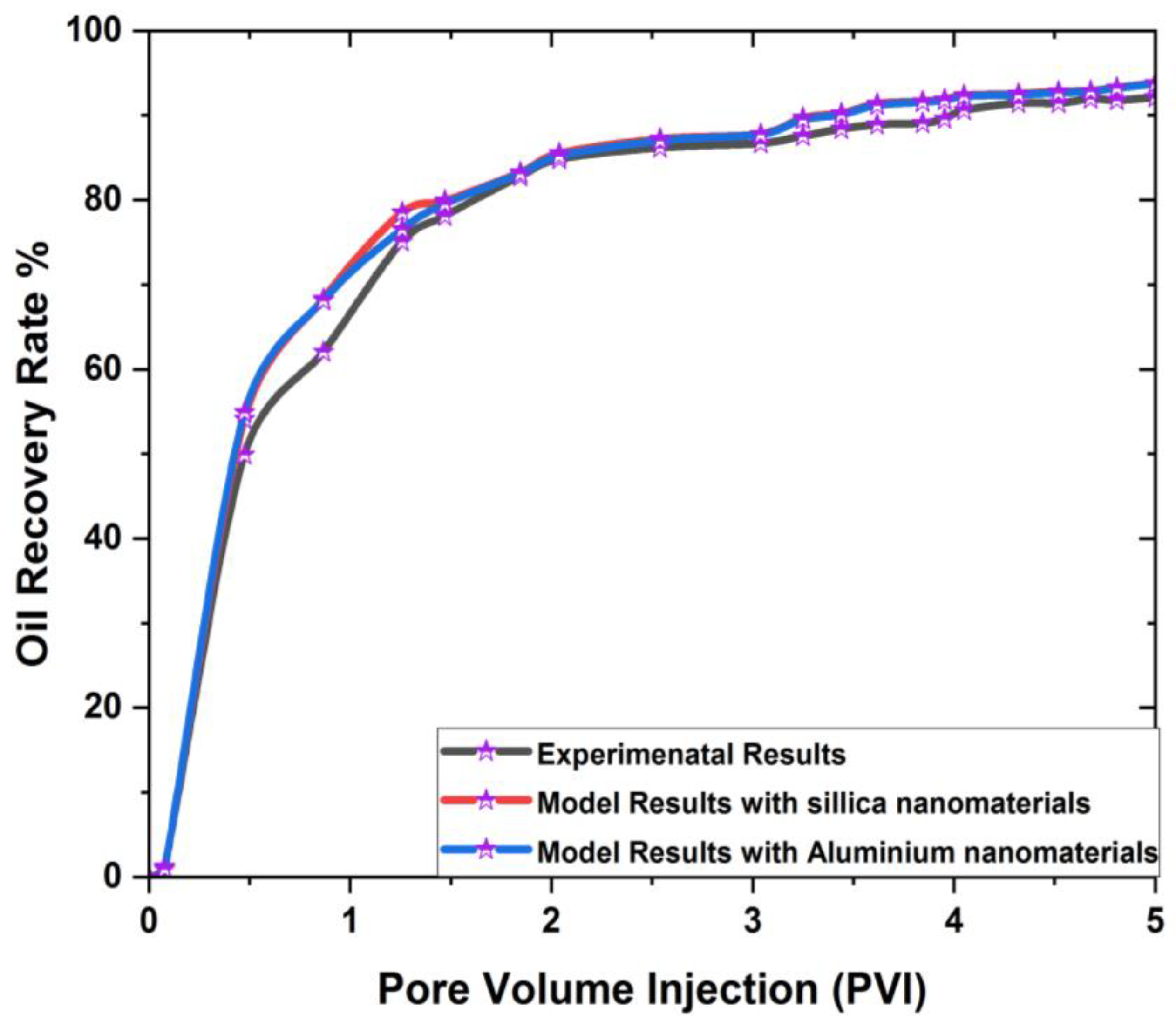

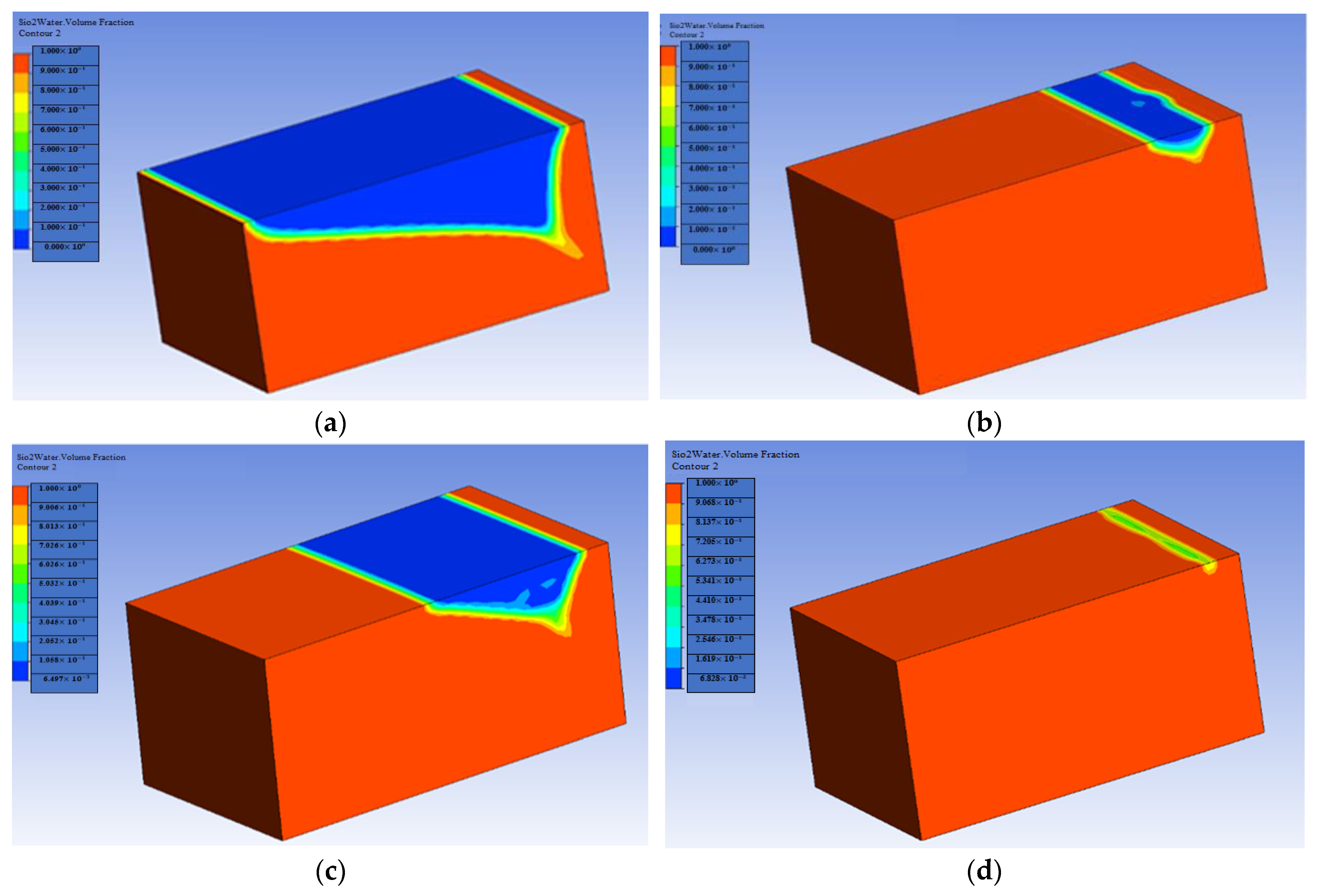
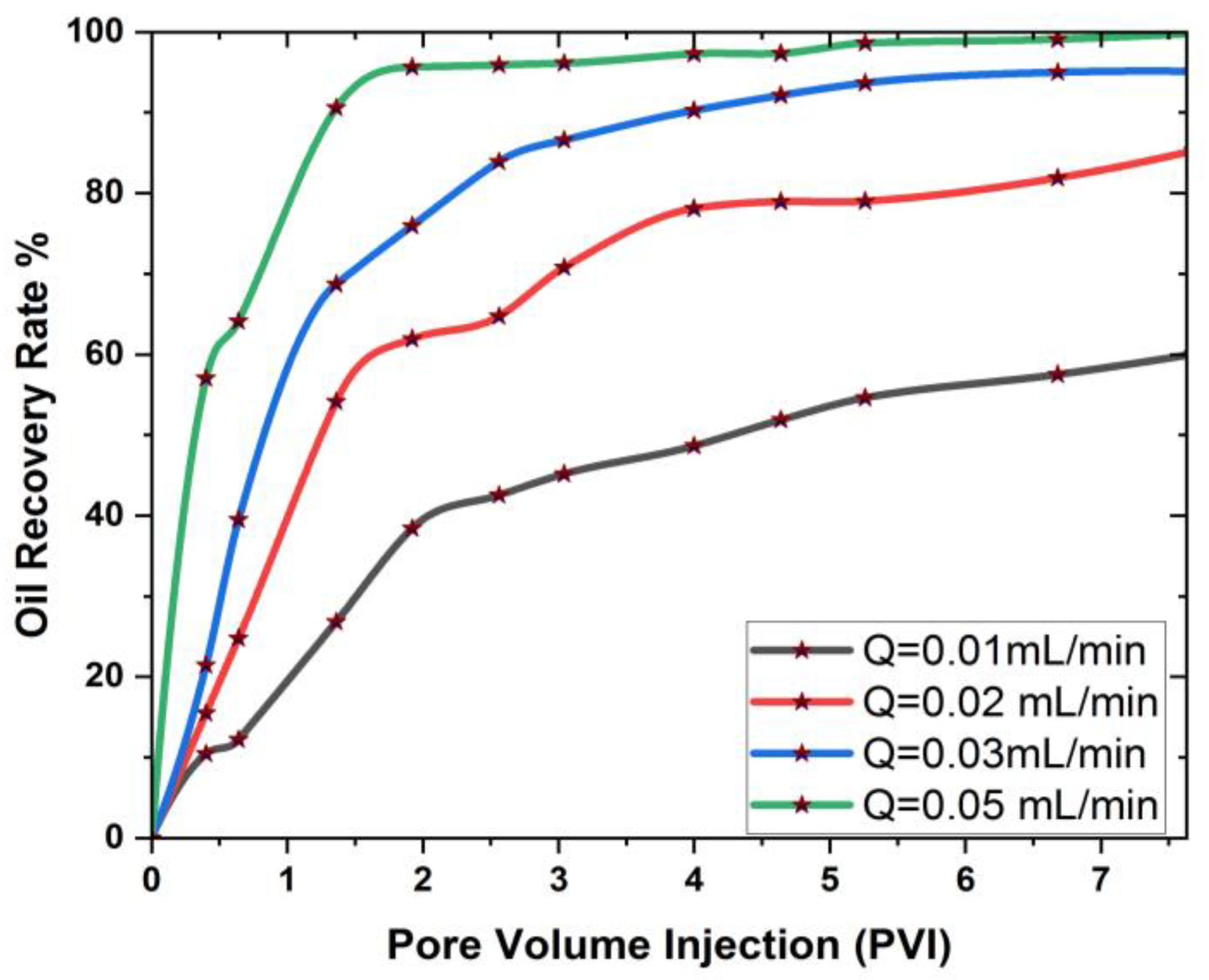
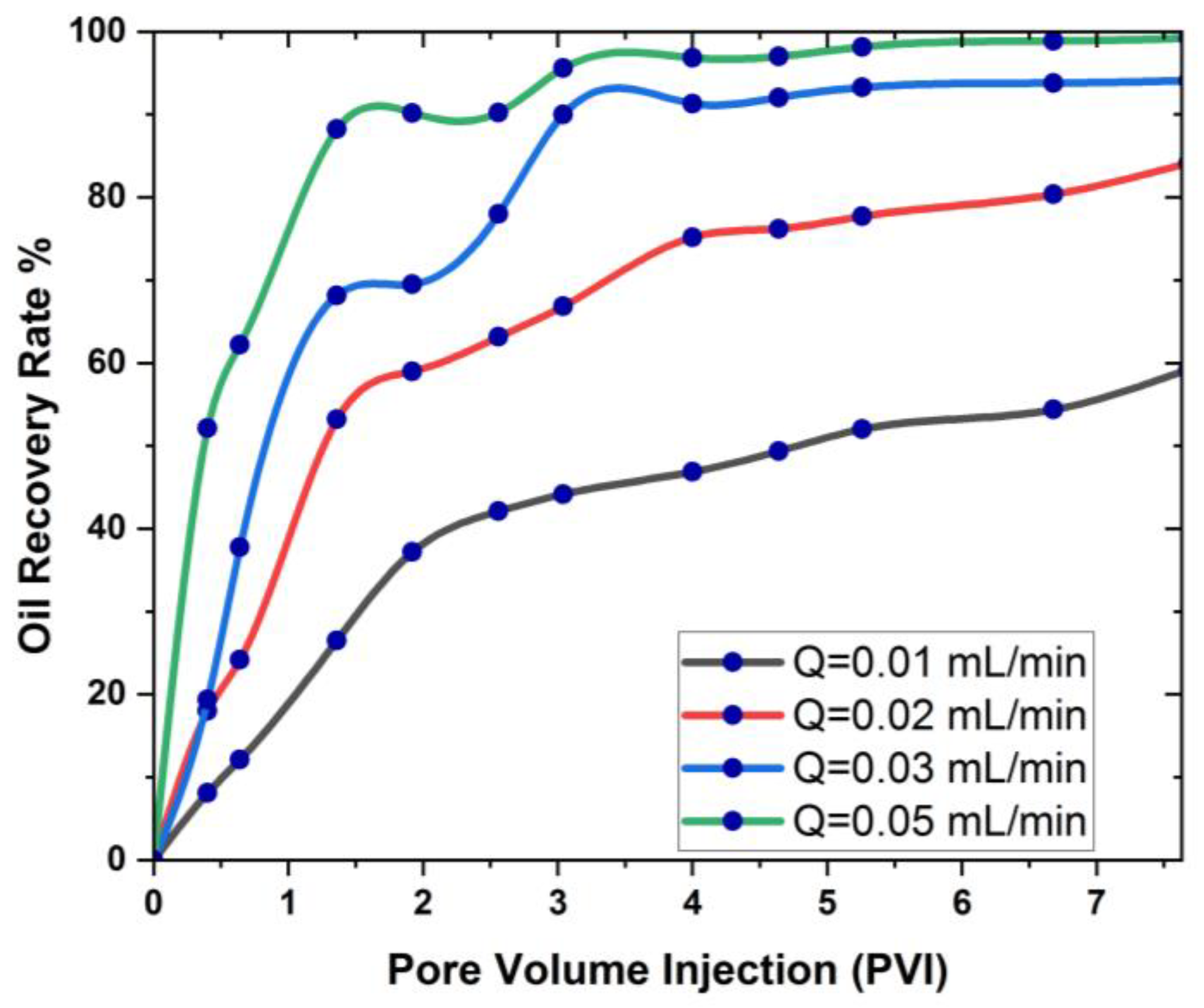
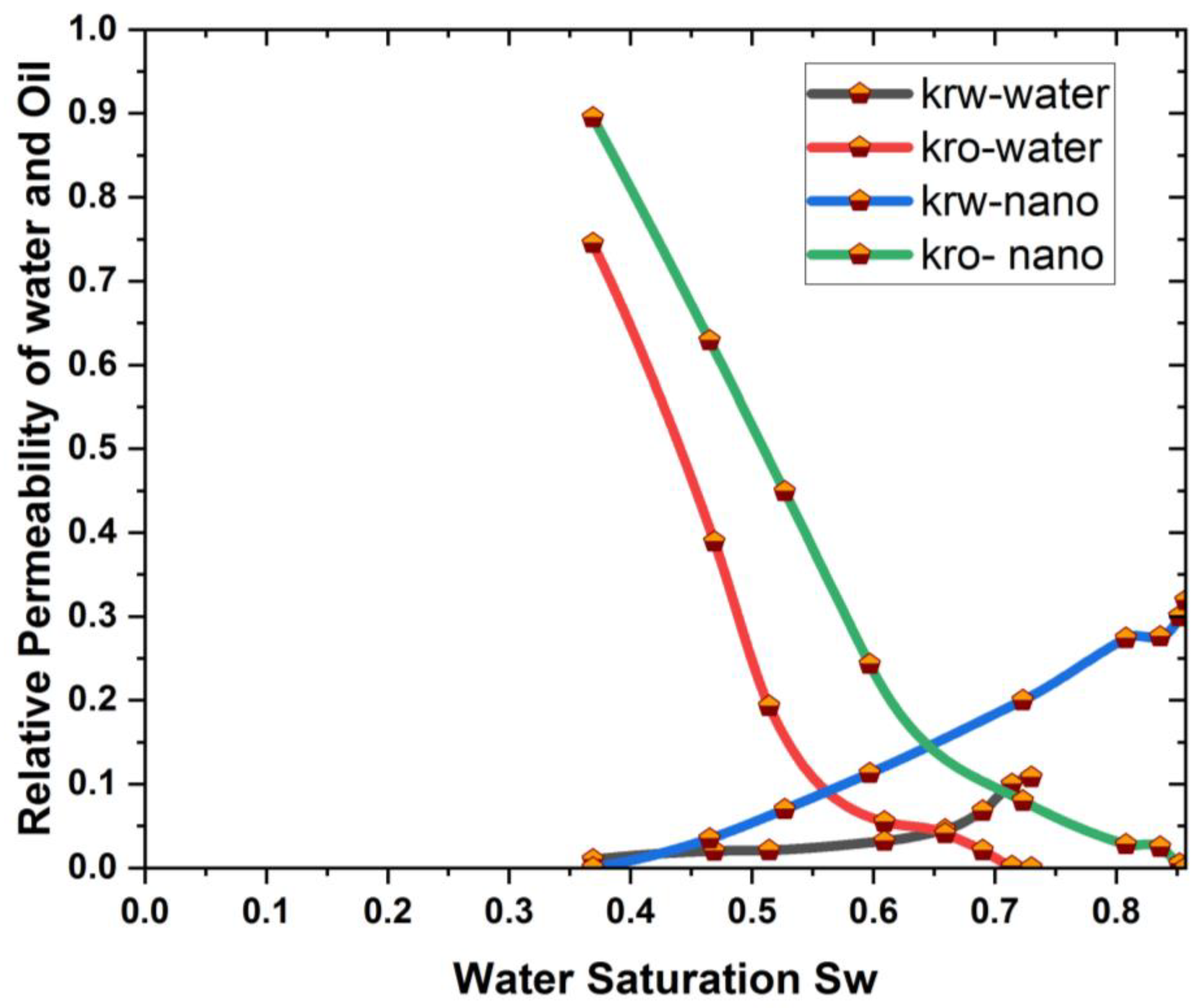


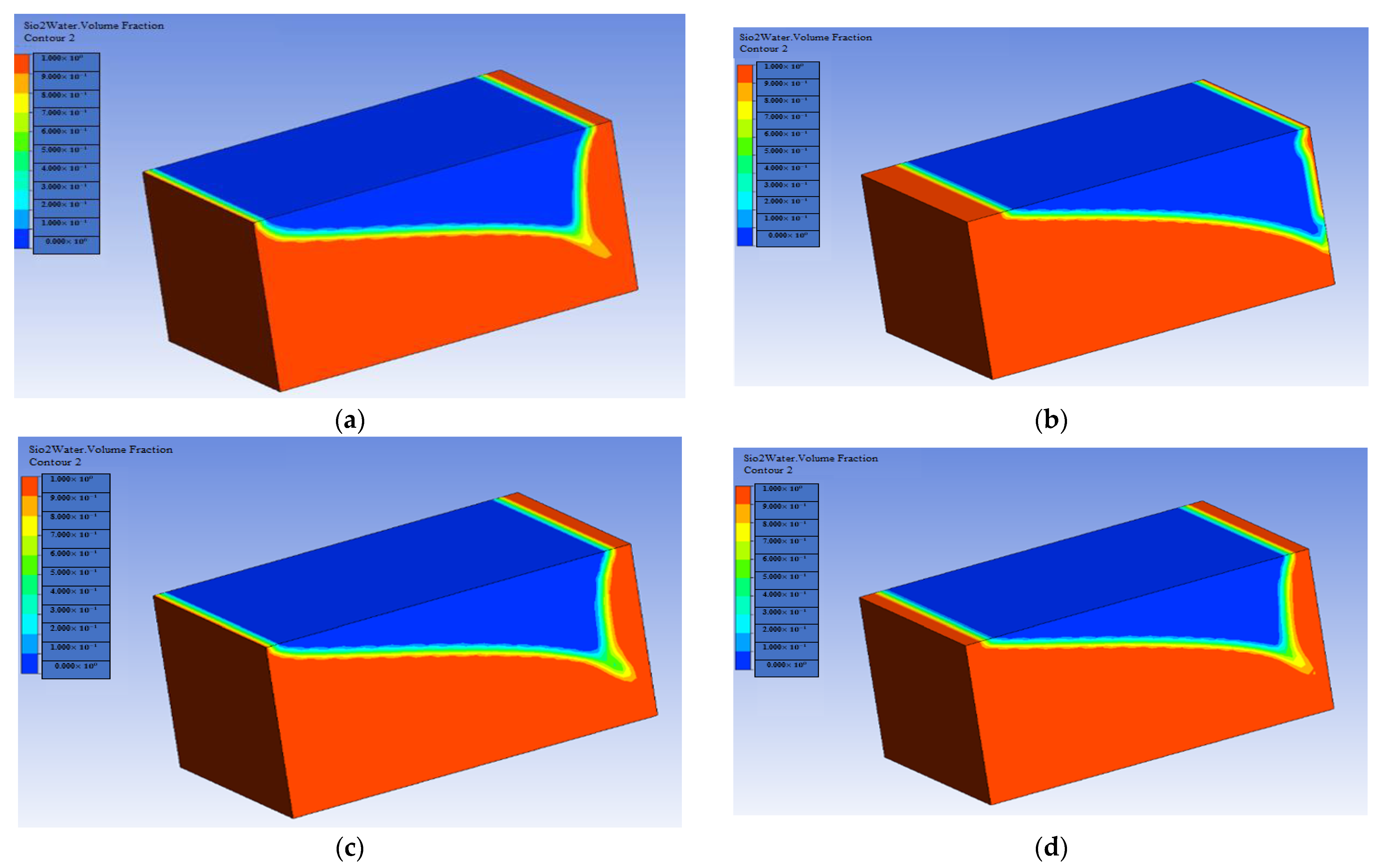
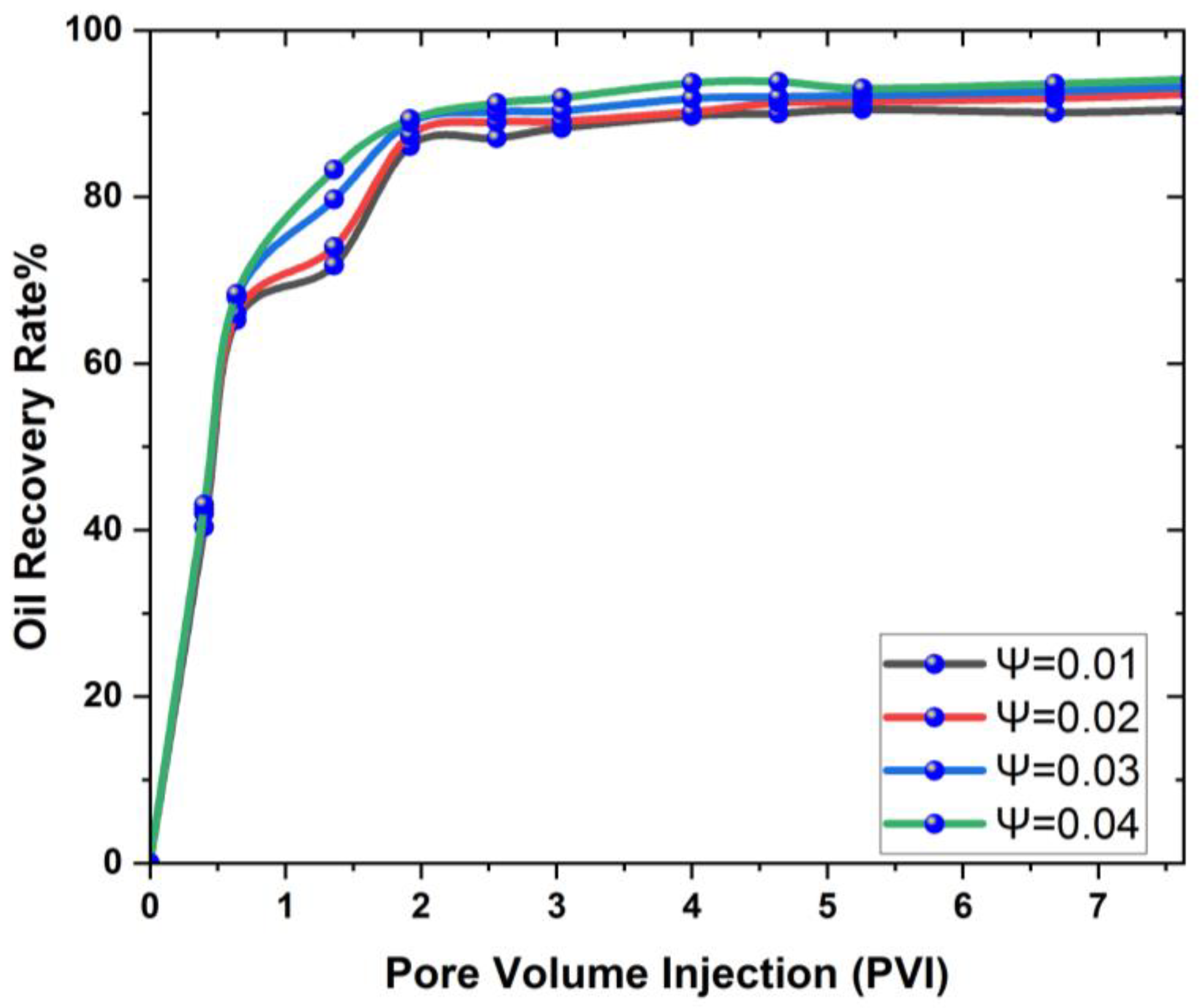
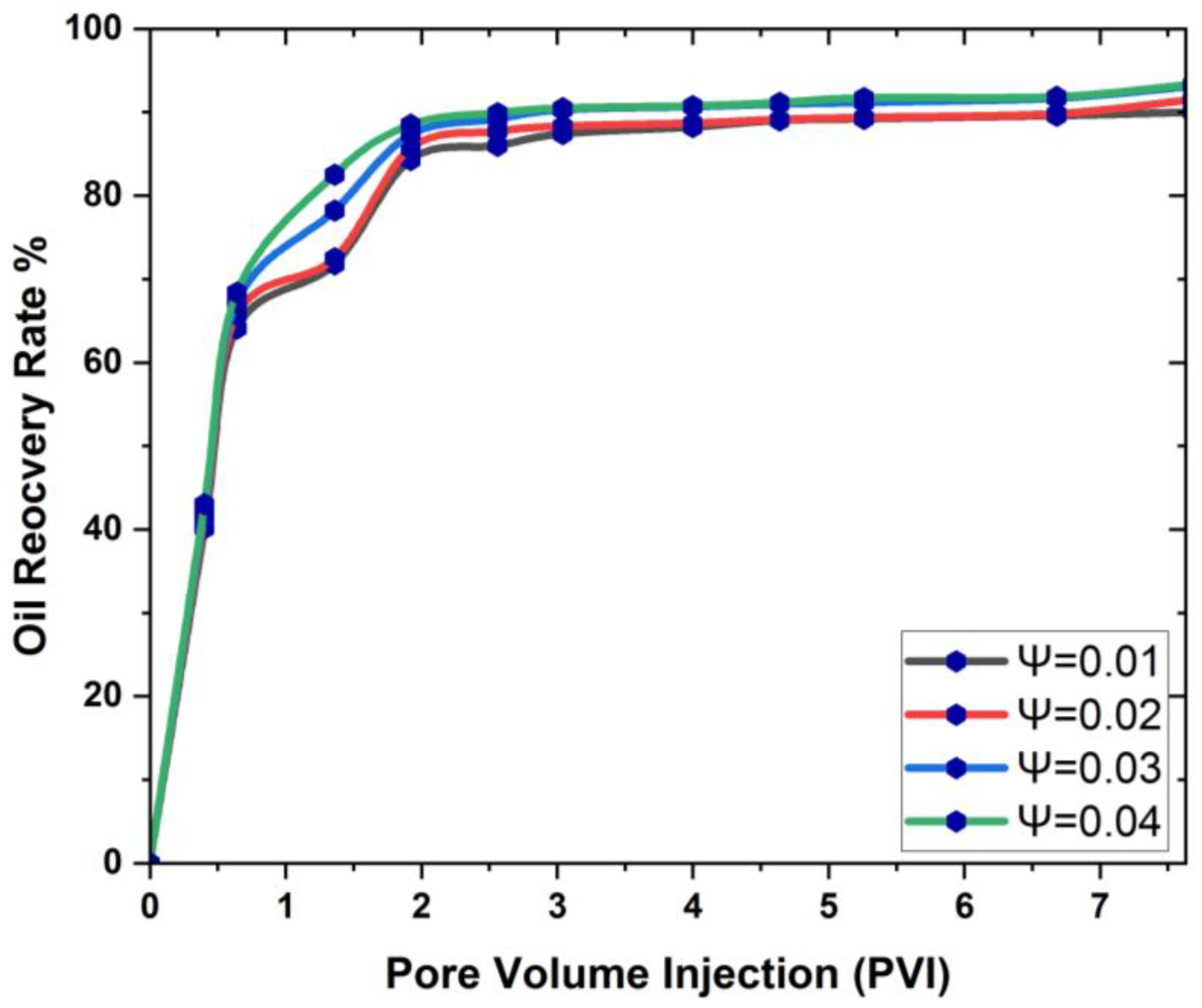
| Physical Quantities | Quantities | |
|---|---|---|
| Parameter of the geometry | Largest width | 0.30 m |
| In radius | 0.12 m | |
| Circumference | 0.15 m | |
| Smallest width | 0.25 m | |
| Length of the side | 0.14 m | |
| Volume and cross-sectional area | Core volume | 0.49 |
| Inlet cross sectional area | 0.45 | |
| Physical properties | Inlet temperature of the fluid | 300 K |
| Initial temperature in cavity | 290 K | |
| Initial input pressure | 1 atm | |
| Final output pressure | 1 atm |
| Nanomaterials/Properties | Physical Property | Value |
|---|---|---|
| Si | Density | 2220 |
| Heat capacity | 745 | |
| Thermal conductivity | 36 | |
| Volume fraction | 0.01 | |
| Diameter | 40 nm | |
| Molecular mass | 60 nm | |
| Al2O3 | Density | 3970 |
| Heat capacity | 765 | |
| Thermal conductivity | 36 | |
| Volume fraction | 0.01 | |
| Diameter | 40 nm | |
| Molecular mass | 101.96 nm | |
| Properties of Oil | Density | 829 |
| Heat capacity | 1670 | |
| Thermal conductivity | 0.13 | |
| Viscosity | 4.5 × 10−4 Pa·s | |
| Properties of Water | Density | 990 |
| Heat capacity | 4200 | |
| Thermal conductivity | 0.6 | |
| Viscosity | Pa·s |
| Physical Properties | Values | |
|---|---|---|
| Reservoir rock | Rock density | 2714 kg |
| Mesh size | Diameter | 3 |
| Boundary Points | Boundary Conditions | Flow Boundary |
|---|---|---|
| Boundary 1 | u · n = Q | Inlet |
| Boundary 2 | No flow enters or leaves | |
| Boundary 3 | No flow enters or leaves | |
| Boundary 4 | Outlet |
| Grid Number | 1 | 2 | 3 | 4 | 5 | 6 | 7 |
|---|---|---|---|---|---|---|---|
| Grid Size | 30 | 3000 | 2456 | 4802 | 13,403 | 30,251 | 325,230 |
| Properties | Range with SI |
|---|---|
| Diameter | 4.15 cm |
| Length | 5.78 cm |
| Permeability | 110.4 mD |
| Porosity | 17.5% |
Disclaimer/Publisher’s Note: The statements, opinions and data contained in all publications are solely those of the individual author(s) and contributor(s) and not of MDPI and/or the editor(s). MDPI and/or the editor(s) disclaim responsibility for any injury to people or property resulting from any ideas, methods, instructions or products referred to in the content. |
© 2023 by the authors. Licensee MDPI, Basel, Switzerland. This article is an open access article distributed under the terms and conditions of the Creative Commons Attribution (CC BY) license (https://creativecommons.org/licenses/by/4.0/).
Share and Cite
Zafar, M.; Sakidin, H.; Dzulkarnain, I.; Hussain, A.; Sheremet, M.; Nazar, R.; Al-Yaari, A.; Asri, N.A.M.; Bashir, S. The Impact of 3D Prism Cavity for Enhanced Oil Recovery Using Different Nanomaterials. Materials 2023, 16, 4011. https://doi.org/10.3390/ma16114011
Zafar M, Sakidin H, Dzulkarnain I, Hussain A, Sheremet M, Nazar R, Al-Yaari A, Asri NAM, Bashir S. The Impact of 3D Prism Cavity for Enhanced Oil Recovery Using Different Nanomaterials. Materials. 2023; 16(11):4011. https://doi.org/10.3390/ma16114011
Chicago/Turabian StyleZafar, Mudasar, Hamzah Sakidin, Iskandar Dzulkarnain, Abida Hussain, Mikhail Sheremet, Roslinda Nazar, Abdullah Al-Yaari, Nur Asyatulmaila Mohamad Asri, and Shazia Bashir. 2023. "The Impact of 3D Prism Cavity for Enhanced Oil Recovery Using Different Nanomaterials" Materials 16, no. 11: 4011. https://doi.org/10.3390/ma16114011
APA StyleZafar, M., Sakidin, H., Dzulkarnain, I., Hussain, A., Sheremet, M., Nazar, R., Al-Yaari, A., Asri, N. A. M., & Bashir, S. (2023). The Impact of 3D Prism Cavity for Enhanced Oil Recovery Using Different Nanomaterials. Materials, 16(11), 4011. https://doi.org/10.3390/ma16114011










